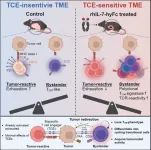Ishikawa, Japan -- Physical inactivity and sitting for prolonged hours are highly prevalent among office-based workers, known to be resulting in various health risks and economic constraints. However, to reduce sedentary time and increase physical activity, health promotion interventions alone are insufficient. The design of workplaces should also be considered to promote interactive behavior among workers.
Many models, such as the socio-ecological model, show how multiple factors interact to influence workers' active and sedentary behaviors. These models specifically magnify the impact of workplace environments in shaping these behaviors. Several studies have also shown that physical environmental factors within and outside the workplace can encourage physical activity among workers. However, several gaps in the existing literature warrant further investigation.
Recently, researchers from the Japan Advanced Institute of Science and Technology (JAIST) have identified three significant gaps in understanding how workplace design influences sedentary and active behaviors among employees. The research team was led by Associate Professor Mohammad Javad Koohsari from JAIST, who is also an adjunct researcher at Waseda University and an honorary associate fellow at Deakin University (Australia), along with Associate Professor Andrew T. Kaczynski from the University of South Carolina, Professor Akitomo Yasunaga from Bunka Gakuen University, Associate Professor Tomoya Hanibuchi from Kyoto University, Professor Tomoki Nakaya from Tohoku University, Professor Gavin R. McCormack from the University of Calgary, and Professor Koichiro Oka from Waseda University. Their study was published online in British Journal of Sports Medicine.
Delving deeper, Dr. Koohsari and his team reviewed existing literature to underscore the importance of investigating these gaps and to suggest future research directions. Elaborating further, he says, “We have focused on the interactive effects of workplace norms and culture, and the spatial layout of buildings on workers’ behaviors, along with the need for accurately measuring these behaviors.”
Workplace norms and culture can influence workers’ sedentary behaviors and determine how workplace design affects above mentioned behaviors. However, existing studies in this area have been conducted primarily in Western settings. So, cross-cultural studies are needed to understand these dynamics across different geographical settings, ensuring workplace interventions are culturally relevant. Moreover, the extension of workplace norms to remote and hybrid work environments could also be explored.
Understanding the full impact of workplace design on workers’ behaviors requires measuring active and sitting behaviors accurately and identifying the locations where these behaviors usually occur. While the global positioning system (GPS) in combination with accelerometer devices are commonly used for this purpose, the signals are less accurate indoors. Instead, an indoor positioning system (IPS), which uses low-cost Wi-Fi and Bluetooth, can precisely locate people within indoor environments. Through its integration with activity-tracking wearable devices, workers’ movements, intensity of activities, and other biometric data could also be collected. Additionally, combining IPS and geospatial AI (GeoAI) to analyze geospatial data could precisely locate people within workplaces and analyze workers’ movement patterns.
Previous studies have considered the impact of isolated design elements on movement and behaviors. However, the overall building layout, which is the spatial arrangement of elements like walls, doors, windows, and access routes, majorly defines the functionality of interior spaces. Yet, it remains unclear which workplace layouts promote active behaviors among employees. Space syntax theory—a method of quantifying spatial layouts using graph-based estimators—could fill this knowledge gap. Dr. Koohsari highlights, “By considering the spatial layout of a whole building rather than only the individual design elements, space syntax could be used to study how factors of building layout, such as locations of common spaces and workstation arrangement, impact workers’ movements and behaviors.”
As digitalization and automation engulf the modern world, sedentary behaviors among office-based workers are expected to increase. In response, Dr. Koohsari reiterates, “Future studies should examine the interactive effects of workplace norms and culture on behavior and conduct cross-cultural studies to identify similarities and differences. Innovative measurement methods can also be employed to accurately measure behaviors and locations where those behaviors occur within workplaces. Additionally, exploring the influence of spatial layout, and utilizing space syntax, can offer valuable insights into the design of work environments that facilitate workers' engagement inactive behaviors. ”
In conclusion, these insights suggest that addressing the existing knowledge gaps is crucial for developing workplace interventions and designing healthy and productive work environments, eventually enhancing the well-being of workers.
###
Reference
Title of original paper:
Active Workplace Design: Current Gaps and Future Pathways
Authors:
Mohammad Javad Koohsari*, Andrew T. Kaczynski, Akitomo Yasunaga, Tomoya Hanibuchi, Tomoki Nakaya, Gavin R. McCormack, and Koichiro Oka
Journal
British Journal of Sports Medicine
DOI:
10.1136/bjsports-2024-108146
About Japan Advanced Institute of Science and Technology, Japan
Founded in 1990 in Ishikawa prefecture, the Japan Advanced Institute of Science and Technology (JAIST) was the first independent national graduate school in Japan. Now, after 30 years of steady progress, JAIST has become one of Japan’s top-ranking universities. JAIST counts with multiple satellite campuses and strives to foster capable leaders with a state-of-the-art education system where diversity is key; about 40% of its alumni are international students. The university has a unique style of graduate education based on a carefully designed coursework-oriented curriculum to ensure that its students have a solid foundation on which to carry out cutting-edge research. JAIST also works closely both with local and overseas communities by promoting industry–academia collaborative research.
About Associate Professor Mohammad Javad Koohsari from Japan Advanced Institute of Science and Technology, Japan
Dr Koohsari is an Associate Professor at Japan Advanced Institute of Science and Technology in Japan. He also is an Adjunct Researcher with the Faculty of Sport Sciences at Waseda University, Japan, and an Honorary Associate Fellow with the School of Exercise and Nutrition Sciences at Deakin University, Australia. He obtained his PhD in Urban Design from the University of Melbourne, Australia, and another PhD in Health and Sport Sciences from Waseda University, Japan. His research focuses on how built environment science can contribute to population health, especially in the context of super-aged societies. Dr Koohsari has a publication record with over 115 refereed journal articles (such as at Nature Reviews Cardiology). In 2020, 2021, and 2022, he was recognised in the top 2% of most influential researchers worldwide across all scientific disciplines (Stanford University & Elsevier). He is also included in the 'Top Scientists' list in the field of 'Social Science & Humanities' for the year 2022 (Research.com). He is an editorial board member of several international journals, such as Landscape & Urban Planning, Heart & Mind, Clinical eHealth, and Journal of Architectural & Planning Research.
Funding information
Mohammad Javad Koohsari is supported by the JSPS KAKENHI (grant 23K09701). Koichiro Oka is supported by the JSPS Grants-in-Aid for Scientific Research program (grant 20H04113).
END








